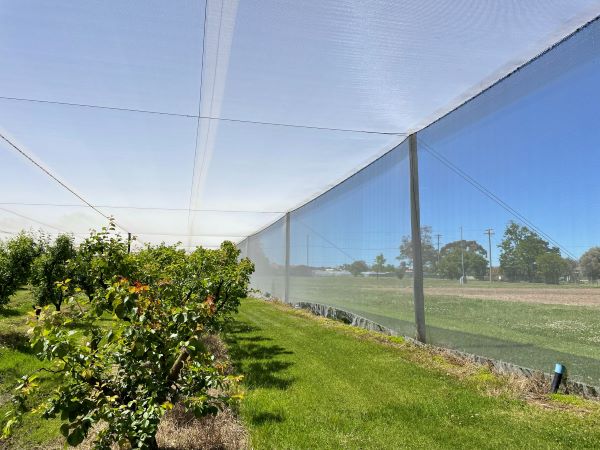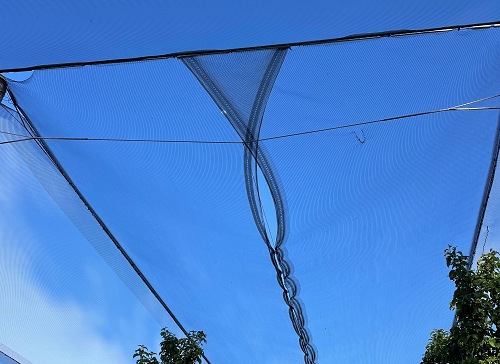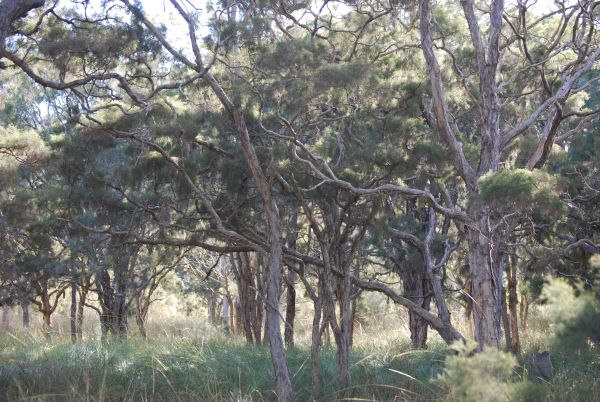Protecting crops from wildlife
Update on flying-fox damage mitigation permits
There are changes to the regulation around applying for damage mitigation permits (DMPs) to protect crops from flying foxes through lethal take.
Find out more about the changes to flying-fox DMPs.
Support for horticultural netting
The Horticultural Netting Program – Trial Expansion, which helps primary producers offset the cost of protecting crops with horticultural netting, is now open for applications.
Additional support to protect crops, such as sustainability loans, may also be available through the Queensland Rural and Industry Development Authority (QRIDA). Contact your local QRIDA representative to discuss your individual circumstances.
Ways to minimise crop damage from wildlife
There are several non-lethal options to protect crops from wildlife.
-
How it works
- Exclusion netting is believed to be the most effective way to protect crops.
- Permanent posts and cables hold full-coverage netting completely over a crop area.
- You can choose from various sizes and colours to meet your main goal.
- Netting can be either permanent or retractable.
Advantages
- Offers protection from wildlife as well as some insects.
- Can lower water requirements.
- Allows some control of the crop ecosystem within netted area, which can result in a more reliable crop.
Disadvantages
- Can be expensive.
- Vulnerable to extreme weather and damage from wildlife.
- Requires ecosystem maintenance inside the structure, such as pollinating some crops.
- Creates plastic waste.

-
How it works
- Hail netting is designed to minimise crop damage caused by hail. It's best for regions where hail is common.
- The netting can stretch and has central openings so hail falls between rows, preventing damage to trees.
Advantages
- Offers significant protection from wildlife in regions vulnerable to hail.
- Focus is on ceiling coverage, so side access can be left for animals or pollinators.
Disadvantages
- The structure is designed to support the weight of the ice, so more support posts and wires are needed. This usually makes hail netting the most expensive type of crop netting to install.
- Wildlife can enter through openings.
- Creates plastic waste.

-
How it works
- Drape or tunnel netting is temporary netting that can be put over crops during fruiting periods.
- It sometimes includes light wire frames.
Advantages
- It's more affordable than other types of netting.
- Offers reasonable protection from wildlife during vulnerable periods while giving complete access to crops at other times.
Disadvantages
- Outer fruit that touches the net is vulnerable to wildlife.
- Wildlife can get caught in or under the net.
- Creates plastic waste.
-
How it works
- Fully enclosed structures offer complete crop protection.
- May include netting, greenhouses and vertical cropping.
Advantages
- Ability to control growing environment and conditions.
Disadvantages
- Can be expensive.
- Structures may be vulnerable to severe weather.
- Condition within structure must be carefully monitored.
-
How it works
Can discourage wildlife by simulating danger through:
- sirens
- recorded sounds
- gas or scare guns.
Advantages
It is:
- low maintenance
- fairly easy to erect and maintain.
Disadvantages
- Noise pollution may disturb neighbours.
- Effectiveness varies. Additional methods are usually needed.
- Wildlife, especially flying foxes, can become accustomed to the noise.
-
How it works
These are products designed to target and deter specific species by emitting a noise (e.g. the call of a bird of prey) that encourages the target animal to move on. Target animals include:
- birds
- possums
- rodents.
Advantages
- Can be tailored to specific problem species.
- Cause minimal disruption.
Disadvantages
- May become less effective over time.
- Can be expensive.
-
How it works
- Lighting can discourage wildlife from orchards.
- For best results, use high-lumen lighting such as flood or stadium lighting.
- It works best for nocturnal animals.
Advantages
- Low maintenance.
- Fairly easy to source and erect.
Disadvantages
- Light pollution can disturb neighbours.
- Variable effectiveness. Usually requires additional methods.
- Wildlife, especially flying foxes, can become accustomed to the light.
-
How it works
Can discourage wildlife from orchards by simulating danger.
Advantages
- It is:
- low maintenance
- fairly easy to erect.
- Wildlife is less likely to become accustomed to lasers than stationary lighting.
Disadvantages
- Light pollution can disturb neighbours.
- Effectiveness varies. Additional methods are usually needed.
- Possible safety issues for humans in the controlled area.
- It is:
-
How it works
- Uses a combination of light, sound and movement.
Advantages
- Randomness reduces potential for species to become accustomed.
- Can be directed at wildlife entry points for maximum efficacy.
Disadvantages
- May not yet be fully tested for crop protection purposes.
- Possible issues around:
- pilot licensing
- height regulations
- battery endurance.
-
How it works
Frost fans are large fans that can circulate air over a wide area. They:
- can be permanent, stationary or portable
- are commonly used to protect crops against frost
- can have the secondary function of discouraging wildlife from the area through noise and air movement.
Advantages
- Fans:
- are low maintenance
- have multiple uses.
- Portable fans can be directed at problem areas.
Disadvantages
- Can be expensive.
- May need further trialling for crop protection purpose.
-
How it works
Planting decoy crops and native plants can encourage wildlife away from primary crops by providing more appealing food.
Advantages
- It doesn't interfere with wildlife's natural behaviours.
- Native plants can be more environmentally friendly.
Disadvantages
- Cost and time from sacrificing crop or new plantings.
- May encourage wildlife to the area if there is a rich food source.

Case studies
-
Farm with:
- 120 acres of strawberries
- 180 acres of apples.
Challenges
Main crop damage issue is from hail. Most damage from wildlife comes from:
- flying foxes
- birds
- ducks.
Protection method
In this region, hail netting is necessary to protect against significant losses from hailstorms. Protection from wildlife predation is an added effect.
The farm:
- was one of the early adopters of netting in the region. Netting has been installed since 1990
- employs hail netting over all trees, except for young trees.
This netting is thicker and requires more wires, supports and repair work to handle the heavy ice load it has to carry. Larger weave exclusion netting is used over the sides of structures to deter wildlife.
Cost and maintenance
Netting must be fully replaced every 5–8 years. This period depends on the:
- number and size of hail events
- quality of the net (e.g. better UV resistance increases the life of the net).
Patching and minor repairs of clips and wires are ongoing tasks. These become more intensive the older the net/structure is. Repairs often take 2 labourers all winter and requires equipment like cherry pickers. It can also require hiring contractors.
The owner spends approximately $50,000 an acre on a new structure with hail netting and expects it to last 10–12 years.
Other outcomes
Netting has been found to:
- reduce the water use for the apple
- increase the cost of pruning because the under-net ecosystem promotes longer shoots.
-
Inland and undulating, 125 hectare property.
Challenges
Property has:
- a history of crop damage from lorikeets and flying foxes
- some hollows that get frost in winter in a dry year.
Protection and control methods
The owner has:
- lighting installed over the entire orchard
- a damage mitigation permit for lethal take
- 7 frost fans on a trailer that can be moved around the property.
The fans are automatic based on the air temperature and disturb the air for approximately 120m from the centre. They must be close enough together to have effective coverage.
Cost
The fans cost about $47,000 each. They offer peace of mind and allowed new areas to be planted.
Operation
The owner has used fans for 3 years, and for:
- frost protection, puts them out in May until around the start of September
- protection from flying foxes, sets them up at the perimeter of the orchard and turns them on from 7:30–10pm during fruiting season (December-March) to discourage the early 'scouts'.
Outcomes
The fans:
- work well against frost, but they haven't yet been tested in a black frost (dry and little dew)
- discourage flying foxes.
The owner found:
- using the fans has no other impact on crops or on water use. Airflow is no worse than a windy day and potential for fruit rub not as detrimental as predation
- maintaining a consistent habit of discouraging practices is the best way to mitigate crop damage from wildlife. This especially applies to flying foxes, as they learn to avoid places where it's consistently difficult to find food.
Also consider…
- Find more information on flying foxes.
- Visit Protected Cropping Australia, the peak industry body for protected cropping.
- Learn more about flying-fox locations by using the National flying-fox monitoring viewer.
- Find out how to establish a private protected area or nature refuge.
- Read more about using orchard netting (PDF, 2.9MB).